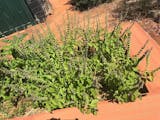The biennial Asian mustard vegetable ‘Tatsoi’ is an ancient mustard cabbage variety with spoon-shaped, dark green and white-veined leaves and a smooth and creamy leaf texture. Unmistakable, pleasant, mildly spicy flavour. Ideal for direct sowing, pot cultivation possible, autumn sowing, good for mixed cultivation, harvesting the leaves.
Description
The Asian mustard vegetable ‘Tatsoi’ is an ancient biennial mustard cabbage variety from Japan and China, dating back to around 500 A.D. This fast-growing vegetable, which has been used for centuries, forms spoon-shaped, dark green and white-veined leaves with a dense and open rosette. The leaf texture of this popular variety is smooth and creamy, with an unmistakable pleasant mild-spicy flavour. The variety is high-yielding and can be harvested over a long period of time. Asian vegetables are eaten fresh or cooked.
General information
Plant family: Brassicaceae
Life cycle: Biennial
Days to harvest: 50 days
Plant height approx.: 25 cm
Root type: Deep rooter
Nutrient requirements: High
Water requirements: Medium
Winter hardiness: Up to -10°C
Location: Sunny
Soil: Permeable, loamy, humus
pH value: 6.5 to 7.5
Sowing and planting information
Germination type: Dark germinator
Sowing depth: 0.5-2 cm
Optimal germination temperature: 10-15 °C
Germination time: 7-10 days
Plant and row spacing: 30x30 cm
Germination ability of seeds: 3-4 years
Mixed culture
Optimal mixed culture: Basil, Marigold, Tagetes, Rosemary, Spinach, Soy, Bean, Pea
Unfavorable mixed culture: Kohlrabi, Onion, Garlic, Mustard, Horseradish, Radish, other types of cabbage
Sowing by climate zone
Subtropic climate (Mediterranean) (e. g. B. Portugal, Spain, Italy)
Direct sowing is recommended in autumn when temperatures drop from September to November. Ideally, the plants should be planted in a sunny location.
Moderate climate (e. g. B. Germany, Switzerland, Poland)
We recommend direct sowing in autumn from July to September and planting from mid-September to early October for overwintering. Ideally, the plants should be planted in a sunny location.
General recommendations
Direct sowing is recommended. After germination, thin out the plants to the specified plant spacing.
Asian mustard vegetable ‘Tatsoi’ ideally prefers a soil that is moist, well-drained, nutrient-rich and contains humus and loam. Does not tolerate waterlogging.
Additional tips
For a longer harvest period, the flower bases should be broken out and care should be taken not to damage the heart during harvesting. Harvest the leaves from the outside inwards to keep growth stable. The use of vegetable protection nets is recommended to prevent cabbage flies from laying their eggs. In order to quickly obtain a fine, crumbly and permeable soil with good nutrient and water storage capacity, it is advisable to additionally incorporate biochar and primary rock flour.
Type of propagation
Propagation occurs via seeds.
Plant care
Loosened, nutrient-rich and constantly moist soil fundamentally promotes growth. Fertilization is not necessary.
Other names
Botanical names: Brassica rapa var. rosularis
English names: Asia mustard vegetable
German names: Asiatisches Senfgemüse, Rosetten Pak-Choi
Portuguese names: Vegetal de mostarda asiática
Spanish names: Verdura de mostaza asiática
French names: Légume moutarde d'Asie
Origin
Country: Portugal




![<tc>Asian Mustard Vegetable Tatsoi [Brassica rapa var. rosularis]</tc>](http://www.benjis.net/cdn/shop/files/AsiagemueseTatsoi-AsianMustardVegetable-Vegetaldemostardaasiatica-Brassicajuncea-www.benjis.net.jpg?v=1705884783&width=1445)
![<tc>Asian Mustard Vegetable Tatsoi [Brassica rapa var. rosularis]</tc>](http://www.benjis.net/cdn/shop/files/AsiagemueseTatsoi-AsianMustardVegetable-Vegetaldemostardaasiatica-Brassicajuncea-www.benjis.net-2.jpg?v=1705884783&width=1445)





